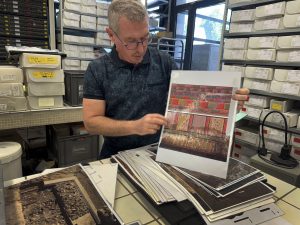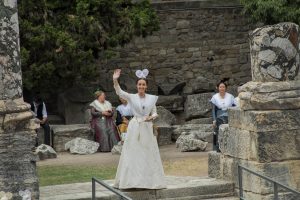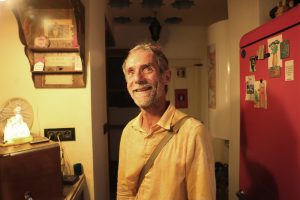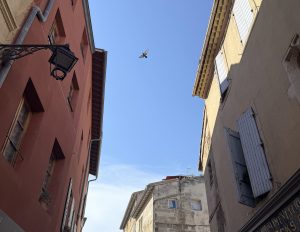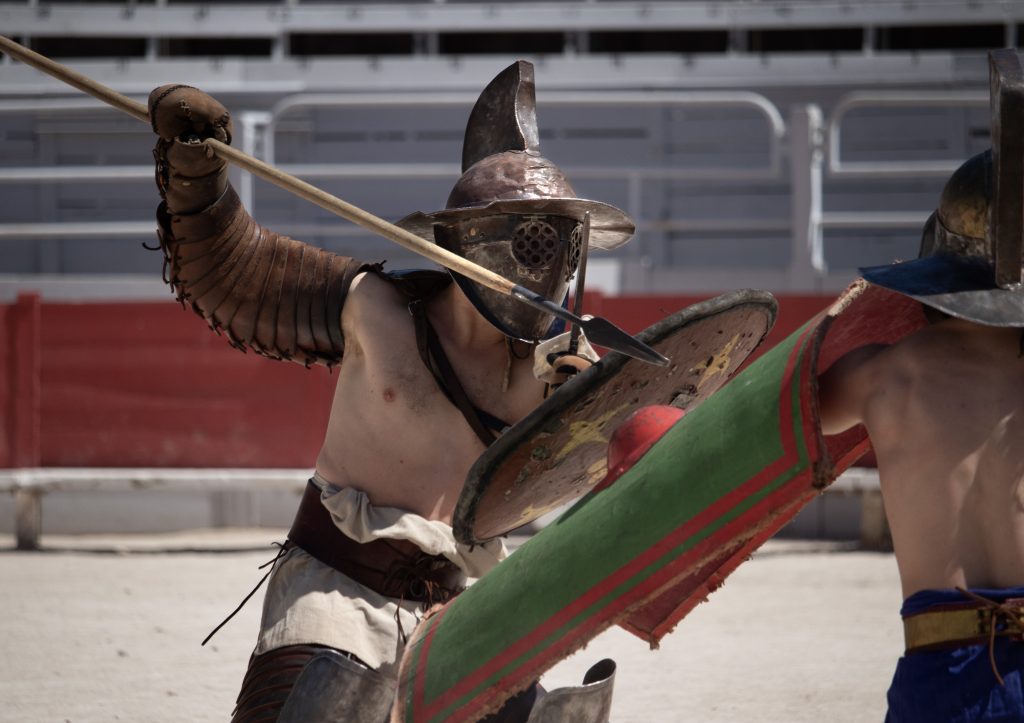
Gladiator Théo Guigonis strikes his opponent Thomas Rankin with his spear during the first fight at the Arles Amphitheatre.
Text by Jack Glagola
Photos by Gwen Murray
One sunny afternoon in the south of France, I saw a real gladiator fight. It wasn’t a hack-and-slash — it was a series of duels between two highly trained athletes crashing into each other with daring footwork and expertly timed attacks and blocks, the ring of metal against metal echoing off the ancient walls. I’d never seen anything quite like it before — it was not a reenactment, it was more than that. It was a sport.
Few cities can boast of having an intact Roman amphitheater in their city center. It’s not only home to bullfights and concerts — the Arles Amphithéâtre also hosts Acta, a troupe of 20 people who painstakingly reconstitute the art of gladiatorial combat, from techniques to weaponry. These fighters are not only athletes — they do research in the field of experimental archaeology.
Gladiators, as a historical group, are misunderstood — Hollywood films like “Gladiator” depict gladiators as slaves or prisoners dragged into amphitheaters and forced to murder their opponents in a sadistic punishment. This could not be further from the truth — gladiators were professional athletes who had ring names like “Hermes” after the god and “Anthrax” meaning poison. They were trained in schools called ludi. They appear on funeral carvings, ancient advertisements, bronze figurines and oil lamps.
Their fights even had referees who would jump in if things got too dangerous. It is only recently that research on gladiators has attracted much scientific interest, and Acta is one of the first groups to conduct experiments in this form of martial art.
Acta is a private company founded in 2006 by Brice Lopez, who directed it before he retired. “It was my profession, and I created structures that allow others to make it their career,” Lopez said. “The people you will see in the arena, that is their profession.”
I met Thomas Rankin, one of Acta’s newest gladiators, at Arles’ Antique Theatre. He originally wanted to be a history teacher but was drawn to living history, in which he has a master’s degree. He began working with Acta as an intern in 2022, and in January, he became a salaried member of the group.
“I really like the blending of teaching and demonstrating,” Rankin said. “I think it’s something sorely lacking from the usual way that people do things.”
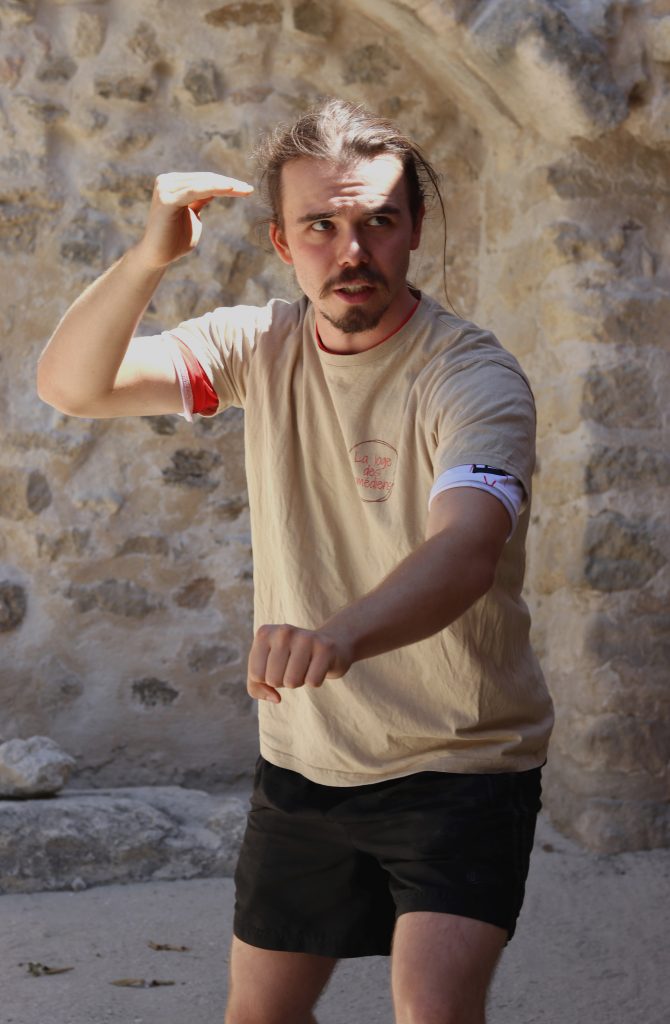
At the amphitheater, Rankin showed me where the gladiators prepare, in the same smelly hallway that the bulls come out during the bull games. He assured me that the gladiators were not the ones causing the smell.
Acta’s gladiators wear modern protective gear underneath their Roman-style equipment; Rankin said they cannot afford it to be “exactly, exactly perfect.” “We don’t have the pretension of being a reenactment group,” Rankin said. “We’re more for the movement than having perfect gear.”
Acta’s primary concern, Lopez told me, is experimental archaeology: recreating historical sport techniques after extensive research. He first became involved in ancient sports 32 years ago: While competing as a high-level jiu-jitsu athlete in Italy, he met a researcher who was looking for fighters to conduct tests with.
“I liked it so much that after that I searched and searched and searched” for other people doing gladiation, Lopez said. “I gave up my sporting career to do that.”
Lopez said their research begins with the sources: actual archaeological objects like swords and armor; iconography and depictions, like frescoes and jewelry; and texts.
“We are not historians,” Lopez said. “Historians start with the texts; we begin with objects, and from these objects, we make a scientific protocol like medicine or hard science.”
Hard science it is: The gladiators test movements “as much as possible,” according to Rankin. The first tests involve the weapons, which are mostly short daggers for use at very close range, slashing over the opponent’s shield.
Acta’s equipment differs slightly from the real deal — the spears and daggers are blunted for safety and longevity. Lopez himself is less interested in materials than the gestures and techniques with them.
“You have a sword; how do you use it? It seems very easy for everyone,” Lopez said. “No. In reality, the gladiators had very specific gestures which we do not have today.”
I saw all these gestures and equipment at the fight in the amphitheater. Spread around the hallway were spears and helmets. I watched the six men get ready, strapping on knee pads, then sandals, then the armor, and warming up by running up and down the hallway, jumping rope and stretching. They let me watch up close, behind the low red walls of the arena.
There were three fights that hour. The final two rounds pitted representatives of two traditional classes of gladiator against each other: a murmillo, who carried a rectangular legionnaire’s shield and a short sword; and a hoplomachus, who wielded a round shield, a dagger and a spear. They fought so hard that I could hear them breathing from where I stood. In the final fight, the hoplomachus’ spear got caught under the murmillo’s arm; the murmillo expertly tossed it away, leaving his opponent with only his dagger and shield. The fight ended in a tie because nobody yielded.
Having now seen a real gladiator fight, I thought about how differently they are depicted. I wondered: Why did these stereotypes take hold?
Rankin told me they emerged from a desire to see gladiators as victims of a sadistic and exploitative system, as well as a conflation of various traditions across centuries.
“The idea of painting Romans out to be so sadistic and decadent justifies the fact that they’re not here and we are,” Rankin said.
Gladiation did not always take the same form. It was practiced for over six centuries — most familiar sports like football and boxing have only existed for a fraction of that time. Gladiator fights were big deals, often lasting multiple days. Large advertisements were painted on walls, much like today’s wheat-pasted posters.
Athletes were paid very well and in advance, so there was no worry of losing a prize if the fight did not turn out as they hoped. Most deaths, too, were among newer fighters, because of pressure and inexperience.
“That’s where accidents happen, but it is really seen as an accident,” Rankin said.
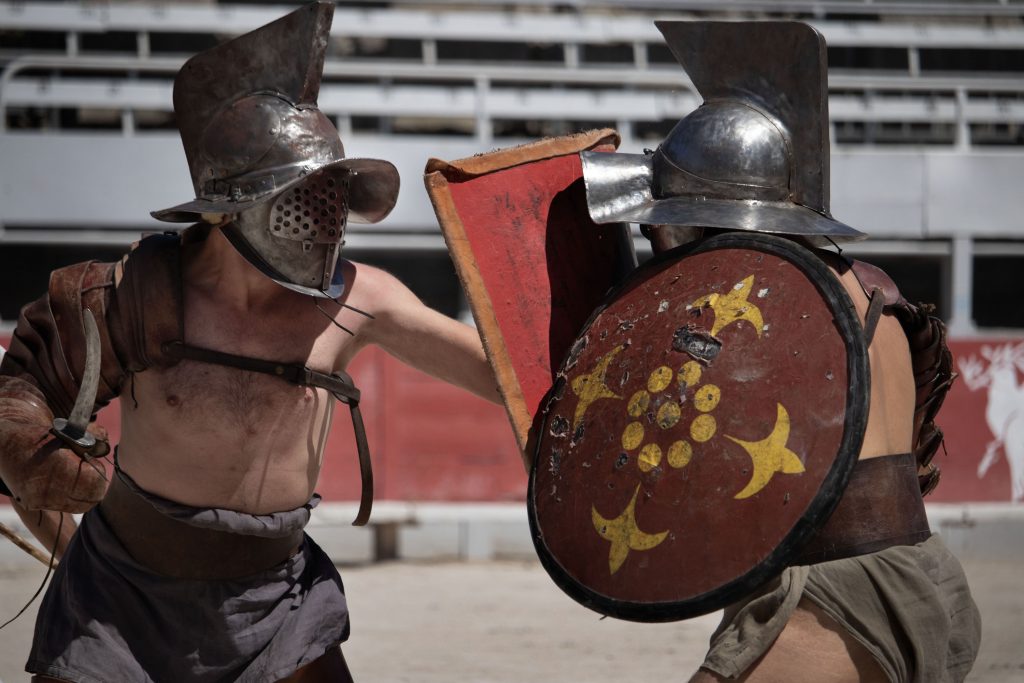
The objective for gladiators is to “conquer without wounding,” to force their opponent to submit without harming him. One gladiator nicknamed “Hermes” is recorded by the poet Martial as one of the greatest fighters because he was able to conquer without wounding.
“It takes so much more talent,” Rankin said. “It’s so much more interesting because it’s very easy to wound someone.”
Gladiator fights had rules; two referees (so they could see over the shields) made sure the fights were both real and safe. Rankin cited the Roman poet Martial, who wrote, “thankfully, the military camp has not been infected by the laws of the fight.”
One reason the rules are still a mystery is that they were mundane, and since gladiation was a spectacle for the common people, elite authors like Cicero, Seneca or Pliny did not write much about them. Researchers like Lopez and archaeologist Alain Genot can infer the rules based on the kinds of wounds seen in iconography. Pictures of gladiators show cuts made by shallow slices on the shoulder blades and the sides.
“You’ll also, in iconography, virtually never see wounds in truly deadly places, like the inside of the thigh, the throat,” Rankin said.
In ancient Rome, making a spectacle of oneself was frowned upon, so gladiators were social pariahs, alongside musicians, actors and athletes. They were seen as unable to fulfill the ideal role in Roman society. That was even more true for Roman women.
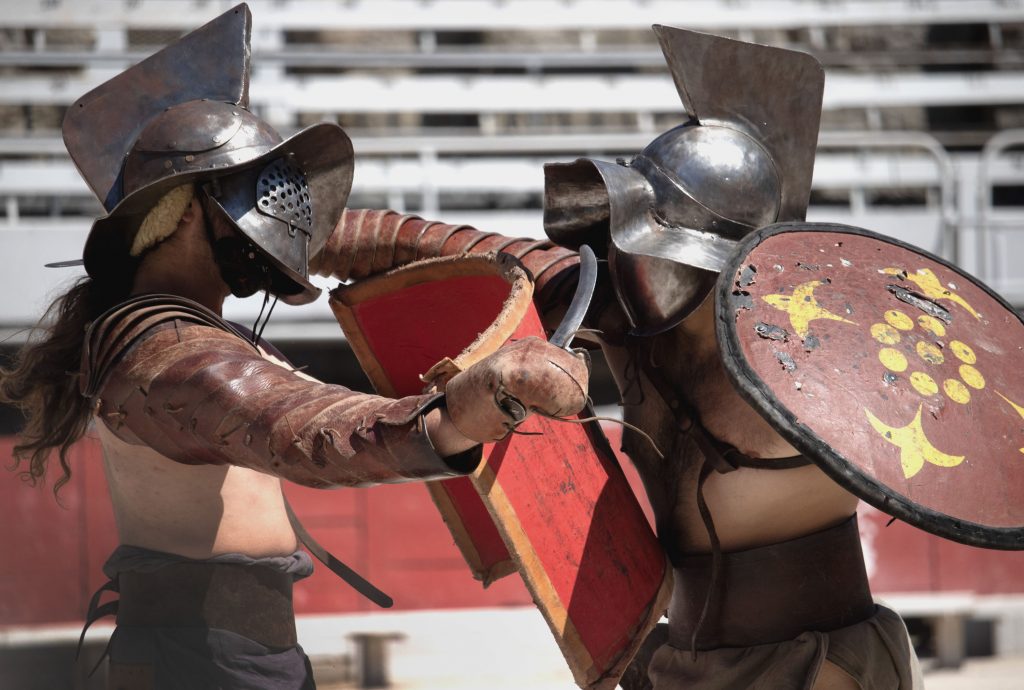
“It’s even more unusual for a woman to fight, so it separates her even more from her idealized view in Roman society,” Rankin said. “But they did exist, even if they were seen as just a cherry on the cake for particularly lavish games.”
Acta is most known for its epic amphitheater duels in summer, but “médiation” (interpretation) is the bread and butter of what Acta does. They visit local schools and conduct activities that demonstrate ancient history, such as military demonstrations, Olympic games and theatre.
When I visited Thomas Rankin at the Antique Theatre, it was during one of these living history lessons.
“The idea is that living the past a little bit gives them some sort of perspective to understand what they see in class a bit better as well,” Rankin said.
Acta, Lopez said, works with “all the museums that possess an archaeological object linked with the gladiators or ancient athletes,” including the museum in Arles.
Genot, an archaeologist at the Musée départemental Arles antique, pointed out that the miniature model of the Arles Amphitheater in the museum is missing any depiction of gladiators.
He said this oversight is because Roman elites saw gladiation as a form of entertainment for plebeians and common people, and this dismissive attitude carried over to contemporary academics.
Genot himself used to take part in the Acta gladiator fights, not as a fully employed gladiator, but to assist in the research. In this way, he and his colleagues helped rediscover techniques as they were depicted on oil lamps and iconography.
“There were lots of moments when we were doing fights, the position was exactly the same as we can see,” Genot said. “It means that we were touching a kind of reality.”
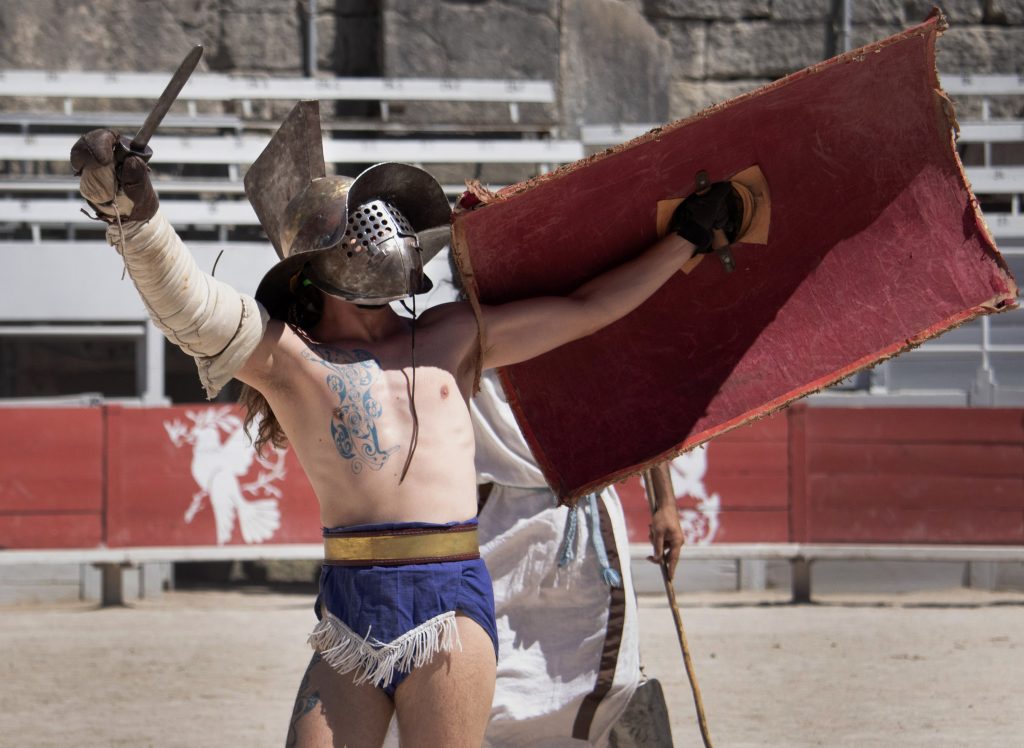
Genot said he first became interested in reconstitutions because a very important part of his work as an archaeologist is to share his work with people, and recreating history is an easy and entertaining way to do that.
“Archaeology belongs to everybody, this is our story,” Genot said. “And when I say our story, this is humanity’s one.”
The first time he saw the gladiators, Genot thought they were “crazy.” “But then you speak with them and you see that they are doing these fights because they want to know how they were fighting too.” He proposed to Lopez that they set up a gladiator school at the museum.
Gladiation, he found, is a real sport that requires discipline and regular practice. When he trained with Acta, the gestures and reflexes became instinctual.
“If you think, you lose,” Genot said. “You have to act, and so you have to practice, practice, practice.”
Monica Ronco and Katie Thornton served as interpreters for this story.
